Warewolf has a range of pre-built connectors, but in this post we’ll focus on the ODBC Connector which allows you to connect to ODBC drivers and execute against any ODBC data source. It allows you to map the data into, execute and then map the data out of the source.
Understanding which data sources can be accessed with ODBC will help determine whether your planned integration route is the best suited for the project at hand. Remember when integrating, Warewolf has other database connectors which could also be used or better suited to your needs. You can find more information on these in the Database section of this knowledge base article.
Open Database Connectivity (ODBC) is a standard application programming interface (API), used to access a database. It allows you to access files in a number of different databases.
The ODBC architecture has 4 Components.
- The Application, which processes and calls ODBC functions to submit SQL statements and retrieve results
- Driver Manager, which loads drivers for the application
- The Driver, which processes ODBC function calls, submits SQL requests to a specific data sources, and returns results to the application
- The Data source, which consists of the data to access and its associated operating system, Database Management System (DBMS), and network platform (if any) used to access the DBMS.
ODBC allows you to access any data source, local or remote for which the user of your application has an ODBC driver installed. ODBC drivers are available in 16, 32 and 64-bit.
The data sources listed below can be accessed using the ODBC drivers.
- SQL Server
- Microsoft Access
- Microsoft Excel
- dBase
- Paradox
- Microsoft Oracle ODBC
- Text files
Visual Studio and Visual C++ contain the ODBC drivers which are installed when Visual Studio is installed. These Drivers can also be downloaded and installed separately, if you are running an older version of Visual Studio.
To find the Drivers which are installed on your computer, and to see if Warewolf can connect to these files from the Studio, you will need to follow these simple steps:
Step1: Hold the Windows button on your keyboard and press R.
Step2: Type in “C:\Windows\SysWOW64\odbcad32.exe” for 64-bit drivers or “C:\Windows\System32\odbcad32.exe” for 32-bit.
Step 3: Select the Excel Files and click Add
Step 4: Select the “Driver do Microsoft Excel(*.xls)” and click Finish.
Step 5: Name the Data Source “Excel Files” and click OK.
We will now connect to this Data Source using the ODBC Connector in Warewolf.
1. Open Warewolf
2. Right click on the Localhost. Hover over sources with your mouse and the drop down menu will appear. Click on New ODBC Source.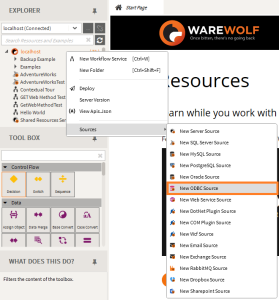
3. A new screen will appear. Server should be set to Localhost and greyed out. Authentication Type will be set to Windows. Click Test Connection.
4. Once the connection has been tested and passed, you will be able to select the Database to which you would like to connect. Using the drop down, select Excel Files.
5.Save the Database source by clicking Save in the main tool bar.
6. Start a New Service by clicking New. Search for the ODBC Connector in the Toolbox by typing “ODBC” in the toolbox search.
7. Drag and drop the ODBC Tool onto the Design Surface. The tool will open in expanded View.
8. Click on the Source dropdown and select your Database Source, Excel Files.
9. The tool will execute your commands against the ODBC on your computer. It allows you to map Warewolf data into, execute and then map Warewolf data out of them. Configure your data and variables and click Done.
ODBC drivers are setup individually and access data from different sources which require the individual drivers to be downloaded, installed and setup.
The ODBC connector in Warewolf is a great tool, as it allows you to access data from everyday Microsoft Office Tools allowing SME’s to enjoy the same ease of integrating as larger corporate companies.
The Warewolf database connectors all have the same functionality. Read the Using Stored Procedures article, which explains how to connect to a database using Warewolf.
Click on the links below to find step-by-step guides to setting up the following Databases.

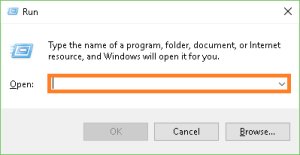
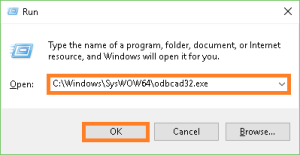
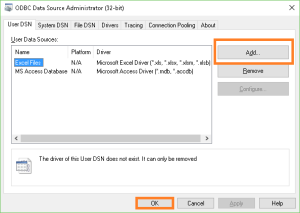
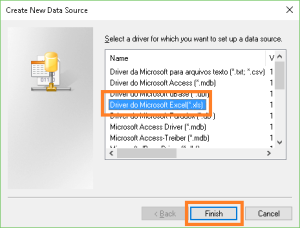
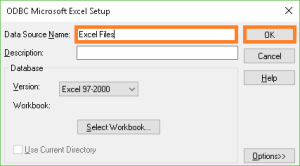


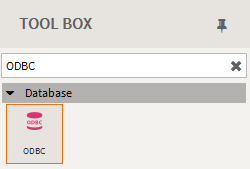
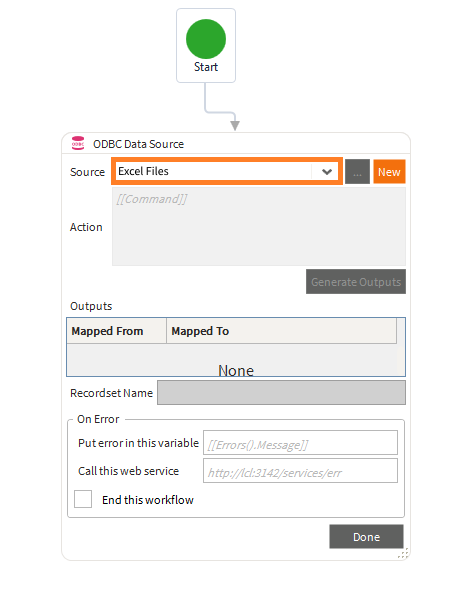






Leave A Comment?